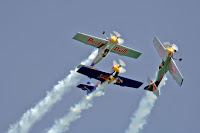Red Bull Air Race
 About Air Race:
About Air Race:The competition features a dynamic new discipline of flying, called ‘air racing’ where the objective is to navigate a challenging obstacle course in the sky in the fastest possible time. Pilots fly individually against the clock and have to complete tight turns through a slalom course consisting of specially designed 20m high pylons, known as ‘air gates’.
 The Air Race is not just about speed but also precision. The slightest mistake can result in penalty points. Flying low to the ground at speeds that can reach over 400kph, while negotiating the air gates, requires immense skill that only a certain number of pilots in the world possess. That is why the pilots are hand selected based upon their expertise and experience. These pilots are at the top of their game. They have to be – the Air Race exerts huge demands on their flying abilities and they have to
The Air Race is not just about speed but also precision. The slightest mistake can result in penalty points. Flying low to the ground at speeds that can reach over 400kph, while negotiating the air gates, requires immense skill that only a certain number of pilots in the world possess. That is why the pilots are hand selected based upon their expertise and experience. These pilots are at the top of their game. They have to be – the Air Race exerts huge demands on their flying abilities and they have to 
The idea of the Air Race was conceived by Red Bull who then approached renowned Hungarian pilot Peter Beseynei to help them refine the concept. The very first Red Bull Air Race took place at AirPower in
11 pilots will take part in the 2006 Red Bull Air Race World Series in 9 spectacular international locations.

‘Air races’ have their roots in the

Aircrafts:
The planes flown by the Air Race pilots are mostly made of advanced carbon composites that can withstand forces of up to 15G and reach top speeds of around 450 kph. They can fly at speeds as low as 100 kph and still perform their unbelievable manoeuvres. Their maximum roll rate is 420 degrees per second, the equivalent of 70 rpm; a spin cycle that makes it impossible for the pilots to perceive the horizon.
"Air" gates:
A slalom in the sky with pilots speeding through the Red Bull Air Race course at over 400 kph? It's extremely exciting but also very risky. That is why it is so important that the obstacles can deal with impact without any adverse consequence to the plane or pilot. One question that's always asked is: what happens when a plane hits a pylon?
Despite their fragility the air gates are also very resilient and can withstand wind-speeds of up to 54 kph without being blown over. This is achieved by making the pylons cone-shaped - at their base they measure five metres across and at their tip 75 centimetres. The 'Air Gates', as the pylons are called, have been painstakingly developed by the Innsbruck based company Bellutti Protection Systems. Martin Jehart and his team have designed air gates that disintegrate when a plane collides with them. They are made from a very light and fragile spinnaker material which rips immediately when touched by an aircraft wing or propeller, so that they simply collapse without any damage or danger to the airplane. Within four minutes an air gate can be replaced by a new one.
The 'Air Gates', as the pylons are called, have been painstakingly developed by the Innsbruck based company Bellutti Protection Systems. Martin Jehart and his team have designed air gates that disintegrate when a plane collides with them. They are made from a very light and fragile spinnaker material which rips immediately when touched by an aircraft wing or propeller, so that they simply collapse without any damage or danger to the airplane. Within four minutes an air gate can be replaced by a new one.
The air gates stand 20 metres high and the distance between each pair is approximately 10 to 14 metres.









